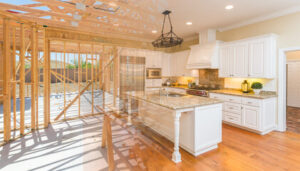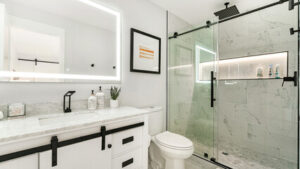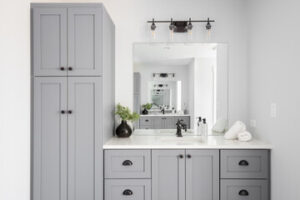A well-designed kitchen is a key selling point for your home. This type of remodel can significantly increase the value of your home and make it more attractive to prospective buyers.

Identify your objectives for the kitchen remodel and create a plan to achieve them. These may include increased storage space, better workflow, or a more modern appearance. Contact Kitchen Remodeling Houston for professional help.
Cabinets are the heart of your kitchen, offering both functionality and aesthetics. From storage space for cookware to shelving that shows off decorative dishes, there are countless ways cabinets can enhance your home. A kitchen remodel is the perfect opportunity to consider upgrades that will boost functionality and elevate design.
While it may be tempting to make major changes during a kitchen remodel, it’s possible to stay within your budget without sacrificing style or quality. These budget-friendly kitchen remodeling ideas will help you get the most out of your new room, whether it’s refinishing current materials or installing a fresh coat of paint.
A well-planned kitchen has the potential to serve as the center of your home’s daily activity. During your remodel, it’s important to determine how you will use the space before choosing cabinetry. Consider things like the size of your appliances, where you will put your sink and how much storage you need for all of your cooking tools. These logistical details will ensure your cabinets are the right fit.
Choosing the right cabinets is an essential aspect of kitchen remodeling, with different styles and materials to choose from. While stock cabinets are a convenient option for homeowners on a tight budget, they degrade over time and may need replacing sooner than higher-quality alternatives.
Consider a cabinet upgrade that blends current trends with your personal style, such as glass front cabinets or louvered doors. Another popular upgrade is installing pull-out shelves, which make it easier to access hard-to-reach items. Lastly, opting for integrated handles can eliminate unsightly and distracting hardware. Adding lighting to upper cabinets can also help highlight your favorite items and brighten dark spaces, which will make your ceilings appear taller.
Countertops
Countertops are the foundation of any kitchen design. They need to be durable, able to handle heat, spills and other everyday wear and tear, and offer an array of color and style options to match your unique tastes. There are many kitchen countertop materials to choose from, but the most important factors to consider include durability, maintenance, and cost.
Quartz countertops are a popular choice, as they’re engineered for strength, stain resistance and low maintenance. They come in a variety of colors and styles, and are available at an affordable price point. Granite countertops are another option, offering natural beauty and elegance for a timeless kitchen design. If you prefer a more contemporary look, stainless steel countertops are a great choice. They’re easy to clean and heat-resistant, and they also have a sleek appearance that will enhance the overall design of your kitchen.
If you’re on a tight budget, but still want to breathe new life into your kitchen, countertop covers and resurfacing techniques are a smart and affordable solution. These DIY kits allow you to refresh your countertops without a major financial commitment, and they can be easily installed by homeowners with limited technical expertise.
Choosing the right kitchen countertops is an essential part of any kitchen remodel, and it can be challenging to decide which material will best suit your needs. An experienced remodeling company can help you balance aesthetics, functionality, and your budget to find the perfect countertop for your home. They can also ensure that your new countertops are well-matched with your cabinetry, flooring and other elements of the kitchen to create a cohesive design. They can also advise you on the pros and cons of different materials, including their durability, maintenance requirements, cost, and customizability.
Backsplash
The backsplash is an extension of your countertop and can extend as high as the ceiling. It protects your walls from moisture, grease, food splatters and other kitchen elements. Backsplashes come in a variety of colors, styles and materials. They also can be a focal point for your design. Choose a backsplash tile that complements your countertops and cabinets for a cohesive look.
Experiment with different sized tiles and layouts to create unique patterns on your kitchen backsplash. Here, a mix of small and large white subway tiles with star shapes accentuate the patterning of this modern-meets-cottage kitchen. To tie the look together, a wood-paneled vent hood adds warmth and texture to the space.
A backsplash is the perfect opportunity to make a dramatic statement in your kitchen. The teal and green hues in this backsplash idea are enhanced by glossy tile with a slightly wavy surface, which also reflects the light. The patterned backsplash adds visual interest to the kitchen without overwhelming other design features, like the granite counters and Shaker-style cabinets.
You can find plenty of creative ideas for your kitchen backsplash, but you should consider your overall style before choosing a material and design. Keep in mind that your backsplash will be visible from the dining room and living room as well, so it’s important to choose a color and pattern that fits with your general style.
While a backsplash won’t increase your home’s value as much as new appliances or a new kitchen island, it can add a splash of color and character to your space. Be careful not to choose a polarizing backsplash that may alienate potential buyers in the future, however, as this can decrease your resale value.
Flooring
The kitchen is one of the most popular rooms to remodel. However, it is important to understand how long the process can take and the costs associated with a remodel. A minor kitchen remodeling project can cost less than $25,000, while a more extensive remodel can be upwards of $150,000.
The first step in any kitchen remodel is evaluating your wants and needs. It is also important to decide how much value you want your kitchen remodel to add to your home. Choosing the right materials is essential to creating a kitchen that meets both your aesthetic and functional requirements.
To get started, research design trends and ideas for your kitchen remodeling project. Browsing websites, magazines, and social media can help you identify your preferred style and color palette. This will be helpful when planning your new layout and selecting cabinets, countertops, flooring, and other finishes.
Once you have a clear idea of your kitchen remodeling goals and budget, it is time to start the actual work. This can include demolition and the rough-in stage, where utility lines are installed. The rough-in phase can be time consuming, especially if there are existing pipes in the way of your remodel. This is when a plumber service like rohrreinigung wien can be helpful in clearing the pipes.
The next step in the kitchen remodeling process is installing drywall and insulation. This can be a labor-intensive task, but it is necessary for the integrity of your kitchen remodel. Once the drywall is up, it can be primed and painted to create a smooth and beautiful surface for your new kitchen. Once the paint is dry, you can install your kitchen flooring. The most common choices for a kitchen floor are tile or vinyl, but composite laminate boards and linoleum are popular alternatives for homeowners on a budget.
Lighting
Lighting is a critical component of any kitchen remodel because it helps define the style of the room, provides functionality, and brings together other design elements. It is also an opportunity to add personal flair and elevate your kitchen’s style. The right light fixtures will complement your home’s color palette and blend seamlessly with the rest of your kitchen.
The key to successful kitchen lighting is a layered design that uses three types of lighting: ambient, task, and accent. Ambient lighting provides overall illumination and creates a warm, welcoming atmosphere. It can be achieved with recessed or flush mount fixtures and can be dimmed for flexibility.
Task lighting illuminates work areas, such as countertops where food is prepared. It can also be used to highlight decorative or architectural features, like open shelving and the tops of glass cabinetry. This type of lighting typically comes from the ceiling, either in the form of a pendant or with a chandelier over an island.
Accent lighting is a great way to create a dramatic effect and bring a sense of depth to your kitchen. It can be achieved with LED strips under cabinets, toe-kick lighting, or even a hidden light in the corner of your pantry that illuminates interior shelves.
We can help you select the best light fixtures for your kitchen remodel to maximize its functionality and beauty. We will consider the layout of your kitchen, the amount of natural light you have, and your budget to recommend the most effective solution for your home. For example, we may suggest enlarging windows or installing skylights to let in more light during the day and provide natural illumination when you’re cooking or dining at night.

